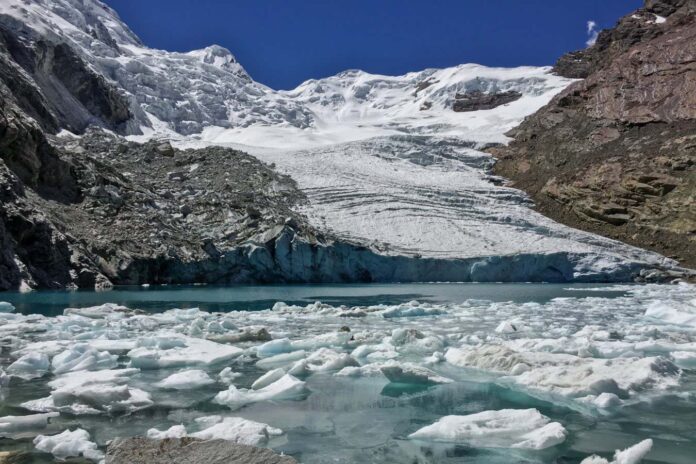
Queshque glacier in Peru is retreating because of global heating
Emilio Mateo/Aspen Global Change Institute
Mountain glaciers in the Andes are almost certainly the smallest they have been for at least 130,000 years, a study of rocks exposed by the melting ice has found.
“This shocked us, frankly,” says Andrew Gorin at the University of California, Berkeley. “I think this is clear evidence that at least one region in the world has now departed the hospitable climatic conditions that have fostered the development of human civilisation.”
The Andes mountain range is so high up that there are permanent glaciers in many places, even in tropical areas. In fact, almost all of the world’s tropical glaciers are in the Andes.
It has been clear for decades that these glaciers are both thinning and retreating as a result of global heating. But how this compares with what happened in the more distant past hasn’t been clear.
Gorin and his colleagues have analysed 20 samples of rock that were recently exposed due to the retreat of four tropical glaciers in the Andes. They looked for isotopes of carbon and beryllium that form when exposed rock is hit by cosmic rays, which can reveal when a glacier last retreated past a certain point.
Similar studies in northerly regions of the world have shown that glaciers there were at their smallest a few thousand years ago, around the middle of the current interglacial period. This is because changes in Earth’s orbit resulted in northern areas getting more winter sunshine, says Gorin, causing glaciers to retreat.
While the shrinking of northern glaciers in the mid-interglacial was a regional rather than global phenomenon, the researchers expected to find something similar in the Andes at that time. Instead, levels of the isotypes they found were so low that they were almost undetectable.
“This is an alarm bell. It’s the canary in the coal mine for mountain glaciers everywhere,” says Gorin.
“We’re quickly blowing past climate milestones that we thought were decades away,” he says. “We chose the specific locations that we sampled at these glaciers with the implicit assumption that these glaciers were not smaller than they have ever been in human history.”
The findings show directly that these glaciers didn’t retreat as far as they have today at any time in the past 11,700 years. Before this point, there was a global glacial period, and studies by other teams show that the tropics were cooler then.
While the study doesn’t say this, Gorin agreed when asked that this means Andean glaciers have almost certainly shrunk to the smallest they have been since at least the previous interglacial, around 130,000 years ago.
“I’d bet my life savings that your assertion that these glaciers are now the smallest they’ve been since the last interglacial is true,” he says. “However, due to the limitations of the technique we used to address this question, we can’t definitively prove that fact, and this is why we don’t say so in the article.”
“This is a shocking piece of research,” says Liam Taylor at the University of Leeds in the UK. “Undoubtedly, the science is conclusively showing that glaciers across the Andes are in a state that they haven’t been in since before the Holocene began 11,700 years ago, and this is directly caused by human activities changing the climate.”
The retreat of glaciers is already affecting farming, drinking water supplies, sanitation and hydropower in the region, says Taylor. This is because glaciers act as reservoirs, storing winter snowfall and releasing meltwater in the summer.
“Many of the glaciers in this region have now passed ‘peak water’, meaning that meltwater that supplies freshwater downstream is drying up,” he says.
In the past century, tens of thousands of people in Peru have also been killed by floods caused by the bursting of lakes formed as the glaciers retreated, says Stephan Harrison at the University of Exeter in the UK. More such disasters could occur around the world as mountain glaciers retreat.
Climate models suggest that mountain glaciers will lose more than 90 per cent of their ice by the end of the century, he says, leaving just a few small glaciers in the highest areas.

